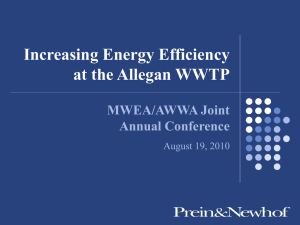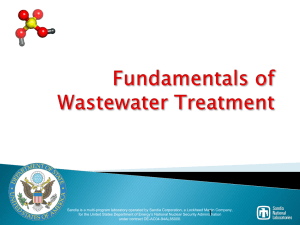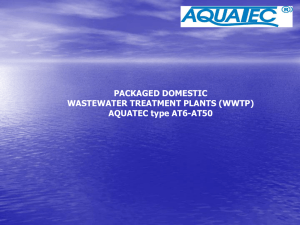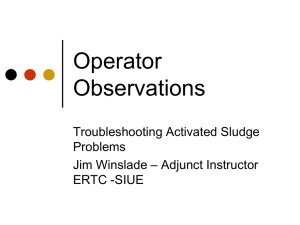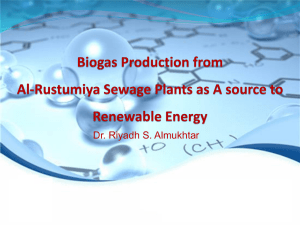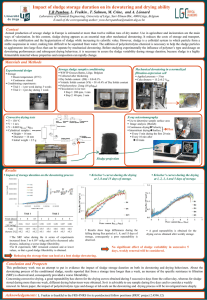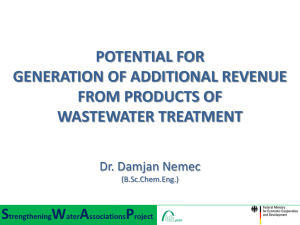ww15_act_sludge_1_slides
advertisement
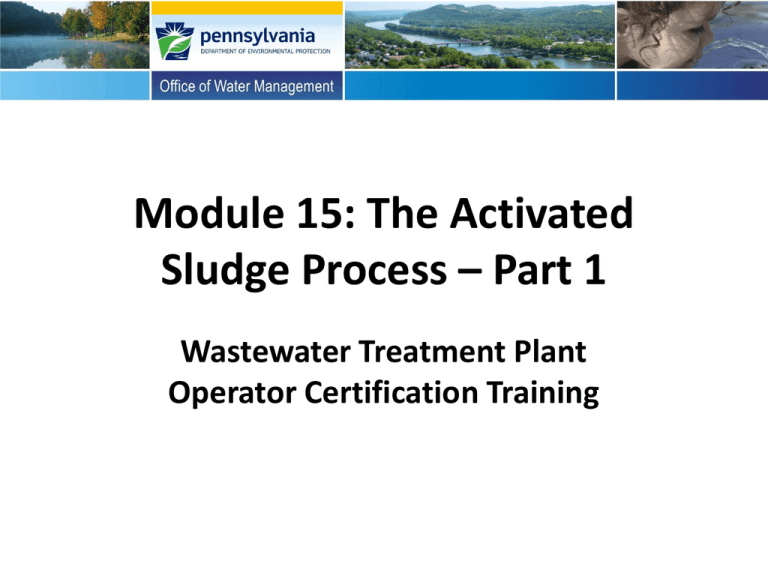
Module 15: The Activated Sludge Process – Part 1 Wastewater Treatment Plant Operator Certification Training Unit 1-The Activated Sludge Process Learning Objectives • Describe the activated sludge process and its control variables. • List three types of activated sludge treatment plants. 2 Aeration System in an Activated Sludge Process Diagram excerpted from Chapter 2: Activated Sludge. In Advanced Waste Treatment. 3 Activated Sludge Process Basics • The ‘Food’ is known as Biochemical Oxygen Demand (BOD). • BOD is the measure of how much oxygen it will take to stabilize the waste (or food) that is in the wastewater. • Strong wastewater will have a high demand; a weak wastewater will have a lower demand. • Organism mass is called Mixed Liquor Volatile Suspended Solids (MLVSS). • Organisms need a balance of food (BOD) and oxygen. • The balance of food to microorganism mass is known as F/M ratio. 4 Activated Sludge Process Basics • An appropriate F/M ratio is necessary to obtain proper performance from the activated sludge process. • Oxidation and removal of soluble or suspended solids takes place within hours in the aeration tank. • Organism activity forms carbon dioxide, water, sulfate, and nitrate compounds. • The remaining solids are changed to a form that can be settled and removed as sludge during sedimentation. • For the process to work properly, the operator must control the number of organisms and the dissolved oxygen in the aeration tank, and the treatment time in the aeration tank. 5 Checkpoint • What purpose does the activated sludge process serve within wastewater treatment? To oxidize and remove soluble or finely divided suspended materials that were not removed by previous treatment (preliminary and primary). 6 Activated Sludge Process Description • Activated sludge is full of organisms that are responsible for the decomposition of wastes. • They use the wastes as food and an energy source for survival and reproduction. 7 Aerobic Microorganisms • Aerobic organisms are the most prominent organisms in an activated sludge plant. – require a proper dissolved oxygen level (molecular oxygen, O2) – produce little to no odor – efficiently oxidize waste – grow relatively quickly 8 Microorganisms • Facultative organisms grow in either an aerobic or an anaerobic (no oxygen) environment. – are less efficient organisms for waste processing than aerobes – produce foul-smelling products of decomposition and incomplete reactions when oxygen is scarce – grow somewhat more slowly than aerobes 9 Microorganisms • An increase in the food (BOD) supply stimulates the organisms’ activity and the rate of oxidation. More organisms are produced, which further increases activity. • The increased food supply creates a demand for more oxygen, which must be provided by the aeration system. • This underscores the need to maintain a proper F/M ratio for stable operation of the activated sludge process and the ability to adjust the aeration rate as the oxygen demand varies. 10 Secondary Clarification • Secondary Clarification – physical process of removing microorganisms and solids from treated wastewater – purpose of the clarifier is to produce a clear effluent suitable for discharge – removes excess organisms from the activated sludge system – provides a source of organisms to return to the activated sludge process as required 11 Examples of Rectangular Clarifiers Diagram excerpted from Chapter 2: Activated Sludge. In Advanced Waste Treatment. 12 Examples of Circular Clarifiers Diagram excerpted from Chapter 2: Activated Sludge. In Advanced Waste Treatment. 13 Sludge Management - RAS • Return Activated Sludge (RAS) - the sludge settled in the clarifier which is returned to the aeration tank. Proper management of RAS is important. – It provides a source of organisms that is returned to the activated sludge process – By changing the RAS rate, the operator can control the concentration of organisms in the aeration tank – Aerobic organisms will die for lack of oxygen if left in the clarifier too long – Caution has to be taken when increasing RAS rates as hydraulic overloading of the activated sludge system can occur. – Increasing the RAS rates increases the volume in the aeration tank and in turn decreases the hydraulic detention time. 14 Sludge Management - WAS • Waste Activated Sludge (WAS) - the sludge removed from the system to prevent buildup of excessive solids in the aeration tank and in the activated sludge process. – WAS can be used to control the amount of MLSS in an aeration tank. – decreasing the WAS rate will increase the MLSS concentration – when increasing or decreasing daily WAS rates, changes should not be more than 10-15 percent of the previous day’s WAS rate. 15 Sludge Management - Table Standard Operating Procedures for WAS Control, Table 2.4,p.70, Advanced Waste Treatment 16 Activated Sludge Process Control • An activated sludge plant requires influent water quality testing and process testing to insure proper treatment. – Influent • Influent BOD testing will allow monitoring of F/M ratio and plant organic loading. • pH and alkalinity and the presence of toxic substances can impact health of the organisms. • Incoming wastewater flow rate will impact the organic loading on the plant. 17 Checkpoint • What happens to the air requirement in the aeration tank when the strength (BOD) of the incoming wastewater increases? Air requirements increase––more food (BOD) encourages biological activity, which in turn requires more air (oxygen). 18 Activated Sludge Process Control • Activated Sludge Process Testing – A number of process variables will impact the performance of the activated sludge process. – Workbook Pages 1-8 to 1-10 includes information on: • the mass of organisms in the aeration tank or activated sludge concentration • MCRT/SRT • dissolved oxygen concentration • the proper distribution of flow to parallel treatment units where applicable, and • management of return activated sludge (RAS) and waste activated sludge (WAS) 19 Activated Sludge Plant Types • There are three basic operational modes for activated sludge plants: – High Rate (modified aeration) – Conventional – Extended Aeration 20 Activated Sludge Plant Types • A high rate plant is operated so the amount of food available exceeds the capacity of the organisms to stabilize it and is characterized by: – High F/M ratio (0.4 to 1.5) – Short sludge age (0.5 – 5 days) – High organism growth rate – 1 to 3 hour hydraulic retention time – Lower than desirable effluent quality 21 Activated Sludge Plant Types • A conventional plant is operated so the amount of food available is limited, requiring the organisms to compete for the available food and is characterized by: – Moderate F/M ratio (0.2 to 0.4) – A mid-range sludge age of approximately 3.5 – 10 days – A slow organism growth rate – Hydraulic retention time of 6 to 8 hours – A good quality effluent 22 Activated Sludge Plant Types • An extended aeration plant is operated so that the amount of food introduced is insufficient to support organisms growth, requiring the organisms to obtain some of their food by endogenous respiration (breaking down their own cellular material) and is characterized by: – Low F/M ratio (0.05 to 0.15) – A relatively long sludge age, generally more than 10 days and often 20 to 30 days – A zero net organism growth rate – A relatively long hydraulic retention time of 18 to 24 hours 23 Variables that Impact Plant Operations • The job of the plant operator is to provide the proper environment for the efficient conversion of colloidal and dissolved solids into settleable biological floc. Some of these variables include: – Influent BOD and changing waste characteristics – Waste Activated Sludge Rate (WAS) – Dissolved oxygen level 24 Ideal Growth Curve for Microorganisms MOP 11, Operation of Municipal Wastewater Treatment Plants, Water Environment Federation,1976 Edition 25 Key Points and Exercise • Turn to page 1-15 to summarize the unit key points. • Turn to page 1-16 for exercises 26 Unit 2–Aeration Systems Learning Objectives • Explain the purpose and methods of aeration. • Identify four types of mechanical aeration. • Describe the three types of diffusers. • Describe plant safety procedures around an aeration tank. 27 Aeration Systems • The purpose of aeration is two-fold: – to dissolve oxygen into the wastewater in the aeration tank – to intermix the mixed liquor suspended solids in the aeration tank with the incoming wastewater. • There are two methods of aeration: – mechanical – diffused 28 Mechanical Aeration Systems • Mechanical aeration systems utilize devices that either splash or mix air into the wastewater and are designed to: – agitate the water surface in the aeration tank to cause spray and waves to enhance the transfer of oxygen from the atmosphere – splash water into the air or entrain (mix) air into the water to enhance the transfer of oxygen – mix the incoming wastewater, the mixed liquor suspended solids, and the air bubbles in the aeration tank. 29 Mechanical Aeration Systems Diagram excerpted from Chapter 11: Activated Sludge. In Operation of Wastewater Treatment Plants, Volume II 30 Diffused Aeration Systems • most common type of aeration systems • consists of pressurized air supplied to a galley of diffusers submerged in the aeration tank • blowers provide the air • piping transports the pressurized air from the blowers to the diffusers • diffusers distribute the air in the tank Diagram excerpted from Chapter 11: Activated Sludge. In Operation of Wastewater Treatment Plants, Volume II 31 Design of Diffused Aeration Systems • Diffused aeration systems are designed to release a continuous supply of bubbles into the wastewater. • Air transfer increases as both the contact time with the wastewater and the surface area of the bubbles increase. • Reducing the size of the air bubbles will increase the rate of air dissolved into the wastewater. 32 Diffused Aeration System 33 Placement of Diffused Aeration Systems • Placement of the diffusers in the aeration tank should optimize the contact time between bubbles and wastewater. • Increasing the depth of the diffusers will increase the rate of air dissolved into the wastewater. • Inducing a rolling pattern keeps the bubbles submerged longer. • Solids do not settle and continuous contact is maintained in order for the processes of decomposition to proceed effectively. 34 Components of Diffused Aeration Systems • The path the air travels through the components is very important. We will be reviewing the major components in the order found to include: – Filters – Blowers (air compressors) – Piping systems – Diffusers 35 Components of Diffused Aeration Systems • Filters – The primary purpose of filters is to keep the diffusers clean by removing dust and dirt before air is compressed and transferred to the diffusers. – Prevent large objects from entering the piping and possibly damaging the blowers. – Dirty filters can cause excessive heat and restrict air flow. – To determine if a filter needs to be changed, the differential pressure between the intake and discharge of the blower will increase. 36 Components of Diffused Aeration Systems • Blowers – Blowers are sometimes referred to as process air compressors. – are generally either a positive displacement type or a centrifugal type. – Let’s take a look at positive displacement blowers first. 37 Rotary Positive Displacement Blower Device Diagram excerpted from Chapter 11: Activated Sludge. In Operation of Wastewater Treatment Plants, Volume II 38 Components of Diffused Aeration Systems • Positive Displacement Blowers – Characterized by: • A rotating set of lobes or rotors that provide a constant volume of air per revolution • A relatively low operating speed or revolutions per minute (RPMs) compared to centrifugal blowers, and • A relatively smaller unit capacity compared to centrifugal blowers. 39 Components of Diffused Aeration Systems • Positive Displacement Blowers – Output Control Mechanisms: • Change the motor RPM for a motor directly connected to the blower. • Adjust the speed using a magnetic drive coupling. • Change the pulley wheel (sheave) sizes for blowers connected to motors with drive belts. • Change the gear ratio for blowers connected to motors via a gearbox. • Change the lobes or rotors in the motor. 40 Centrifugal Blower Diagram excerpted from Chapter 11: Activated Sludge. In Operation of Wastewater Treatment Plants, Volume II 41 Components of Diffused Aeration Systems • Centrifugal Blowers – Characterized by: • A rotating impeller that provides a variable volume of air per revolution, depending on the output pressure required. • A relatively high operating speed (RPMs) compared to positive displacement blowers. • A relatively larger unit capacity compared to positive displacement blowers. 42 Components of Diffused Aeration Systems • Centrifugal Blowers – Output Control Mechanisms: • Change the pressure requirements for the aeration system. • Change the impeller size or design 43 Components of Diffused Aeration Systems • Blowers, in summation; – Positive displacement blowers operate at a constant volume and deliver a variable pressure that depends on the system needs. – Centrifugal blowers deliver a volume that varies inversely with the pressure required by the system. – Are there any questions? 44 Air Distribution Piping Diagram excerpted from Chapter 11: Activated Sludge. In Operation of Wastewater Treatment Plants, Volume II 45 Components of Diffused Aeration Systems • Air Piping Systems – Consists of pipes, valves, and metering devices. • Air mains transfer the bulk of the air from the blowers to the smaller distribution pipes. • Air headers are smaller distribution pipes that transfer air from the mains. • The air lines that distribute the air from an air header to the air diffusers are sometimes referred to as headers also, if they supply air to a number of diffusers mounted on branch air lines. 46 Swing Header Diagram excerpted from Chapter 11: Activated Sludge. In Operation of Wastewater Treatment Plants, Volume II 47 Fixed Headers Diagram excerpted from Chapter 11: Activated Sludge. In Operation of Wastewater Treatment Plants, Volume II 48 Diffusers • Diffusers distribute air into the aeration tank to dissolve oxygen into the wastewater and to enhance mixing. Three general classifications of diffusers are in common use. – Fine bubble diffusers – Medium bubble diffusers – Coarse bubble diffusers • Classifications are related to the size of the air bubbles they produce. 49 Examples of Fine Bubble Diffusers • Fine bubble diffusers are available in various designs including tubes, discs and domes. 50 Fine Bubble Diffusers • Benefits include: – relatively high oxygen transfer efficiency which means reduced energy costs – transfer efficiency of approximately 6-15% • Disadvantage include: – susceptibility to clogging – limited air handling capacity compared to other diffuser types – relatively greater capital cost compared to other diffuser types 51 Medium Bubble Diffuser Nylon Sock Diagram excerpted from Chapter 11: Activated Sludge. In Operation of Wastewater Treatment Plants, Volume II 52 Medium Bubble Diffusers • A common medium bubble diffuser design employs a synthetic (i.e., nylon or Dacron) sock clamped to a plastic diffusion tube as seen in the previous slide. • Medium bubble diffusers strike a balance between cost and performance. • Oxygen transfer efficiencies of approximately 5-12%. • Maintenance is less rigorous than for fine bubble diffusers; however, care must be taken to minimize the impact from dirt and dust in the pressurized air. 53 Example of Course Bubble Diffuser 54 Course Bubble Diffusers • Coarse bubble diffusers are available in the widest range of designs. To keep the cost down, coarse bubble diffusers are commonly made of plastic. – The benefits of coarse bubble diffusers are: • relatively low cost • greater air handling capacity • less maintenance concerns – The main disadvantage of coarse bubble diffusers is the relatively low oxygen transfer efficiency of approximately 4-8%. 55 Safety Procedures • Practice the ABC of Safety: - Always -Be -Careful • Always perform proper lock out/tag out procedures when dealing with electrical and mechanical systems and follow confined space entry procedures. 56 Safety Procedures • • • • • • Aeration Tanks & Clarifiers Mechanical (Surface) Aerators Air Filters Blowers Air Distribution System Air Headers and Diffusers 57 Safety Case Study • You are an operator at a wastewater facility where you will be changing the diffusers in an aeration tank. The aeration lines are equipped with swivel joints, so you can keep the tank in service during the change out. There was a rain shower an hour before the scheduled change out. Please identify safety concerns associated with this operation and how you would address the concerns to make the operation safer. 58 Safety Case Study Concern Slips, trips, and falls Possible Solution Make sure the walking surface is clean and dry (remove slime and brush away standing water). Keep handrails in place, if possible. Wear fall arrest device. Drowning Wear flotation device. Shut off aeration to the header being serviced. Overhead falling hazards Wear hard hats. Ensure lifting devices are securely attached. Ensure lifting devices are functioning properly. Pressurized line Relieve the line pressure prior to any work. Wear protective eyewear. 59 Key Points • Turn to page 2-16 to summarize the unit key points. • Turn to page 2-17 for the Unit 2 Exercise 60 Unit 3–New Plant Start-Up Procedures Learning Objectives • Explain the purpose of plant and equipment review prior to plant start-up. • List equipment and structures that need to be checked. • Explain the plant start-up procedure. 61 Document Familiarization • Review Operation and Maintenance Manual – A complete O &M manual is usually provided. • Review Manufacturer’s Manuals – Should be provided and available for each major piece of equipment • Review Record Plan – Record plans will summarize the as-constructed information on the plant. 62 Equipment Familiarization • Review Equipment and Piping Locations – Field review plant construction – Spend time with manufacturer during equipment startup – Learn how each piece of equipment works and the maintenance required • Ensure all equipment is functioning properly prior to putting into service 63 Checkpoint • If your waste treatment plant were missing a particular manufacturer’s manual, how would you go about obtaining one? Call the manufacturer or contact the manufacturer’s rep and request another copy. Be prepared to provide the equipment serial number, which should have all the necessary information. As additional verification, provide the equipment model number and size, and a purchase contract number if available. 64 Equipment Familiarization • Flow Control Gates and Valves – Check valves for seal and function – Record data: valve positions, turns and opening direction – Touch up protective paint coating and lubricate valves 65 Equipment Familiarization • Piping and Channels – Inspect piping and channels for any debris and remove as required. Debris can block or damage valves, gates and pumps. – Repair any protective coatings as needed. Damage to these coatings will deteriorate quickly as well as the material/equipment they are to protect. 66 Equipment Familiarization • Weirs – Weir maintenance may have a significant impact on the operation of plant components and effluent compliance. – Check level of weirs and adjust as needed – Unlevel weirs may cause an imbalance in flows 67 Checkpoint • Why should an effluent weir be level? To prevent short-circuiting of effluent, to maintain the intended overflow rate, and to minimize solids carry-over, which could occur if high velocity flow patterns are created by the uneven weir setting. 68 Equipment Familiarization • Froth Control System – The system consists of a water spray that is applied to the surface of the activated sludge in the aeration tank. – Check the overall operation of the system prior to filling the aeration tanks. It will be more difficult and dangerous to check when the aeration tank is full. • Check nozzles • Check piping for leaks 69 Equipment Familiarization • Air System - the air system consists of filters, blowers, headers, and diffusers. – Check filters for tight seal and foreign objects – Check system pressure with a manometer or gauges – Check piping for debris – Check the blowers – Check all air headers for leaks – Check diffusers 70 Secondary Clarifier Diagram excerpted from Chapter 11: Activated Sludge. In Operation of Wastewater Treatment Plants, Volume II 71 Equipment Familiarization • Once all equipment and system checks have been completed, the process start-up is begun. The remaining part of this unit addresses process startup. 72 Process Start-up • Process Units – Process units follow a methodical start-up procedure. – Each is brought online one at a time. – Various checks must be done for each process unit. – Let’s start by taking a look at an aeration tank. 73 Aeration Tank Diagram excerpted from Chapter 11: Activated Sludge. In Operation of Wastewater Treatment Plants, Volume II 74 Process Start-up • Aeration Tank – Starting the biological process in the aeration tank is the most important task for this unit. • Start air blowers before filling the tank and monitor the dissolved oxygen and adjust the air supply to maintain desired levels. • Seed with activated sludge from another tank if needed. It will take time to achieve a stable MLSS. • Fill to overflow to secondary clarifier 75 Process Start-up • Secondary Clarifier – Fill all clarifiers – Start collector mechanism and return sludge pumps at 3/4 full. Try to keep sludge retention time in the clarifier to less than 1.5 hours. – Manage the RAS rate to build a solids inventory in the aeration tank and a sludge blanket in the clarifier. 76 Process Start-up • Disinfection System – Start the disinfection system when the secondary clarifier is full and overflowing into the disinfection tank. – Adjust the disinfection system, and if chlorination is used, vary the feed rate to control the chlorine residual. – Check the manufacturer’s literature and O & M manual for any adjustments needed for other forms of disinfection. 77 Process Start-up • Froth Spray System – Use as needed. The initial startup of the aeration tank may create substantial foaming. – Operate the froth spray system as required. – If the froth spray is not available, consider using a commercial defoamer in the aeration tank. 78 Checkpoint • Blowers should be started prior to admitting primary effluent to the aeration tank. Why? To prevent the diffusers from clogging. Without the air discharging through the diffusers, solids would settle on and stick to the diffusers, but with the air discharging that is less likely. 79 Process Control • Air System and Dissolved Oxygen (DO) Levels – As the microorganism population increases, increase the air supply to maintain a target dissolved oxygen range. – Monitor DO levels in aeration tank periodically, adjust air to suit DO levels and tank mixing. – Note that during the initial plant startup, DO levels may be high because of the low number of organisms initially present. 80 Process Control • Clarifier Solids – Rapidly return clarifier solids to aeration during initial startup and monitor sludge return rates. – Due to the low number of organisms in the aeration tank, the RAS rate from the clarifier would be a higher return percentage due to the thinner sludge. – As the solids inventory in the aeration tank increases, the return rate of a thicker sludge would be less. 81 Process Control • Testing – Take 30-minute settleability tests on activated sludge in aeration tanks. – Begin process calculations as activated sludge process comes on line to monitor MLSS levels, F/M ratio, etc. – Periodic testing, not only during plant startup but during normal operation, is a key component to operating an efficient plant. 82 Key Points and Exercise • Turn to page 3-13 to summarize the unit key points. • Turn to page 3-14 to complete the exercise 83
